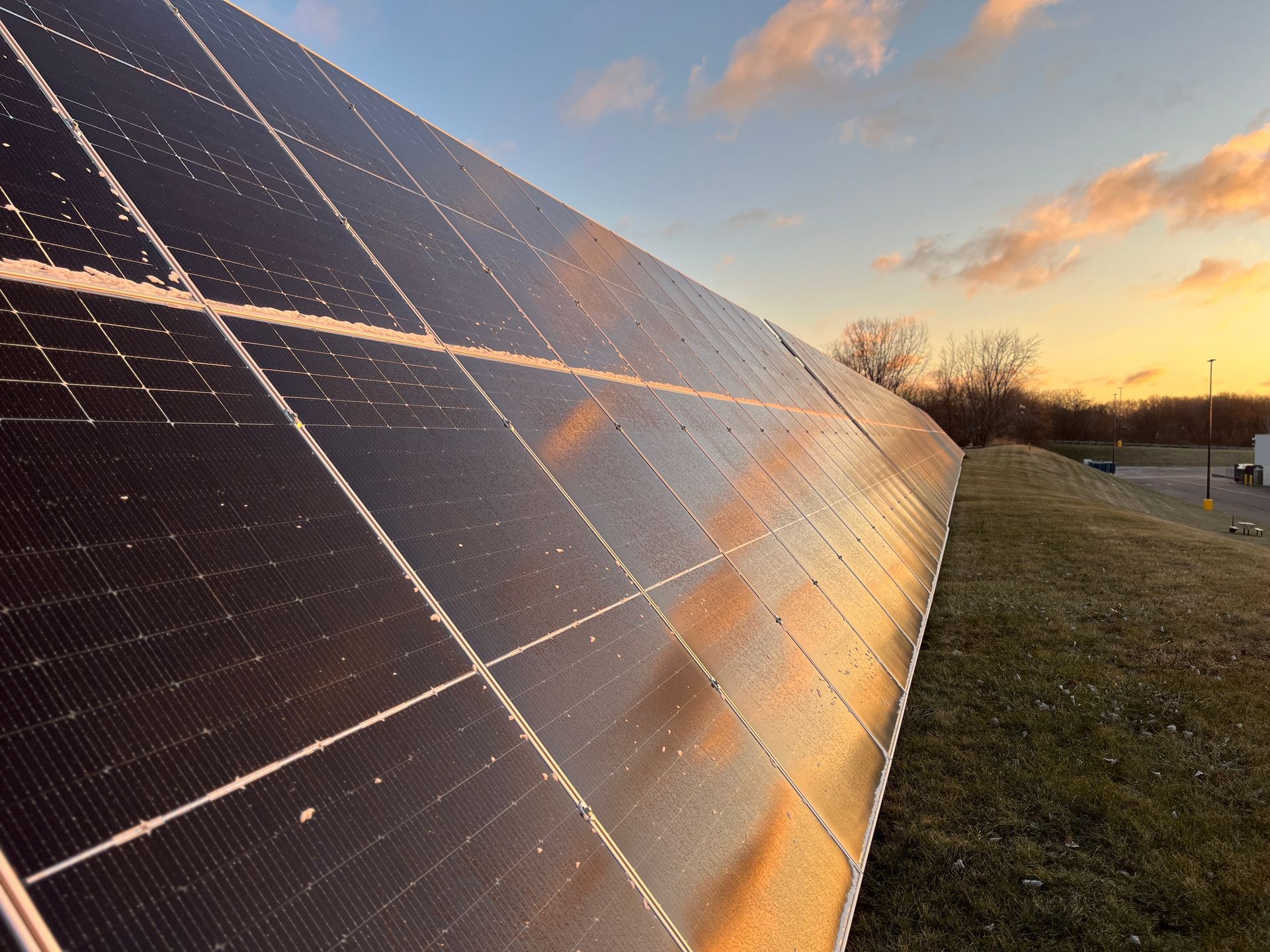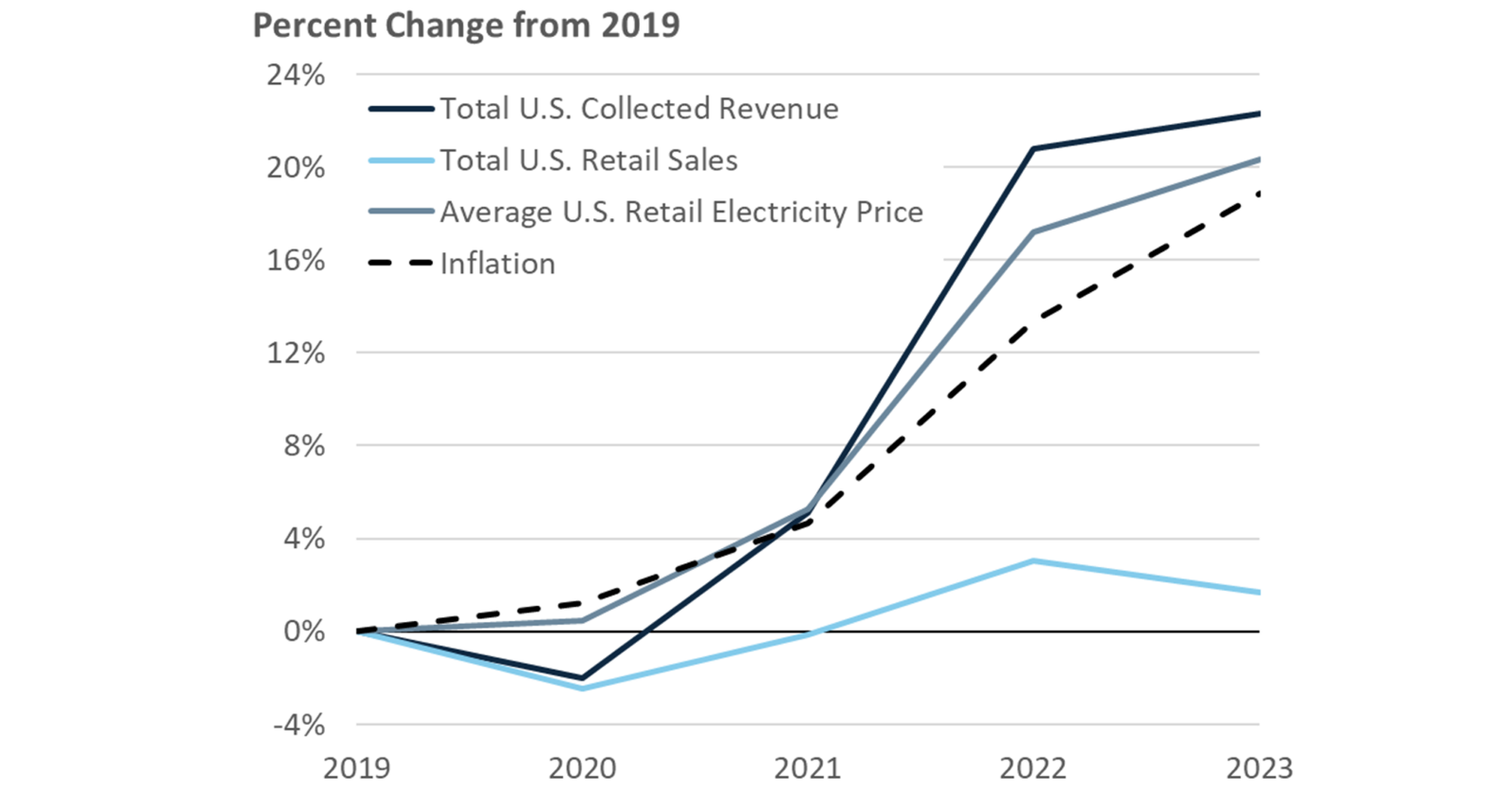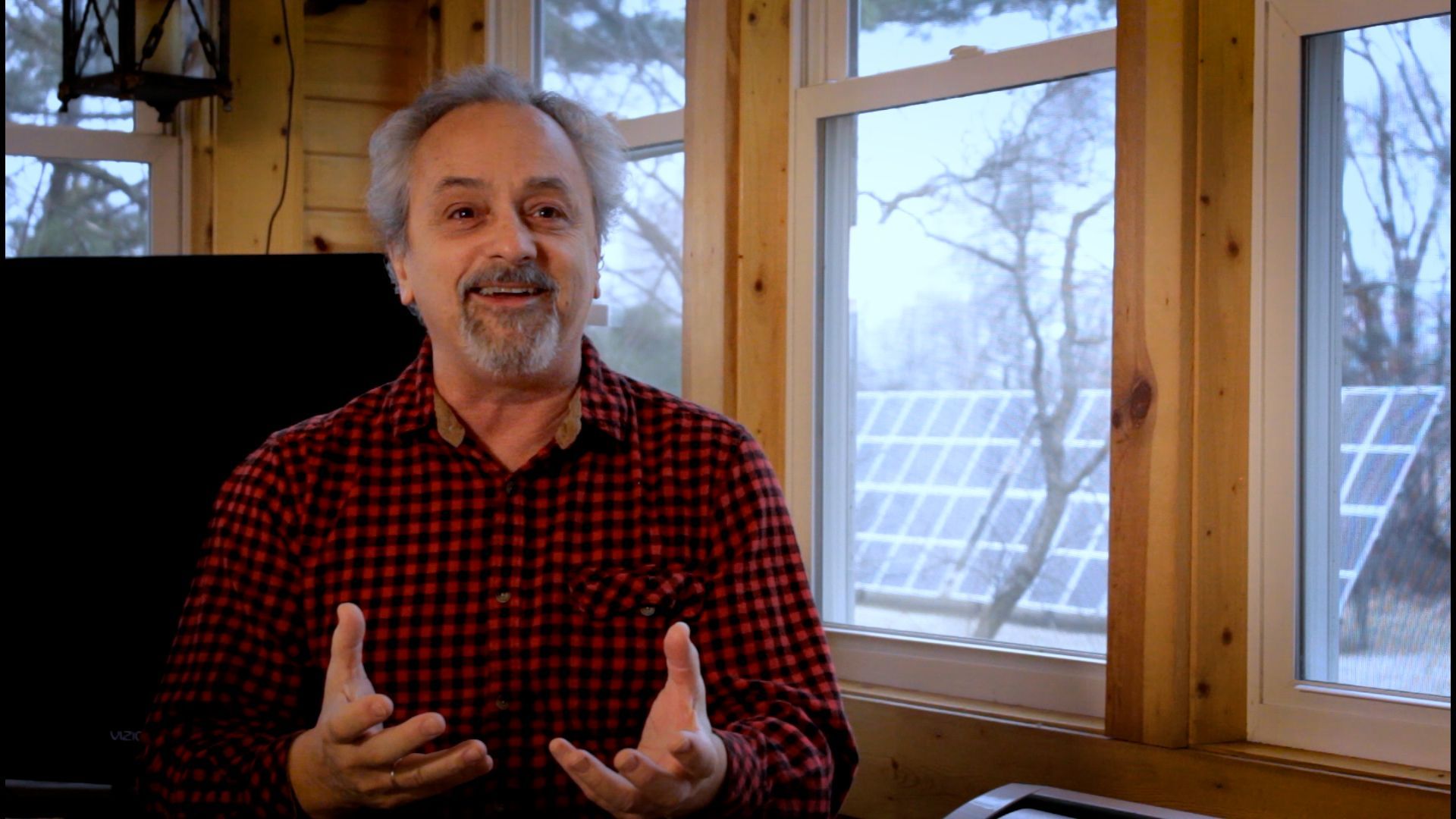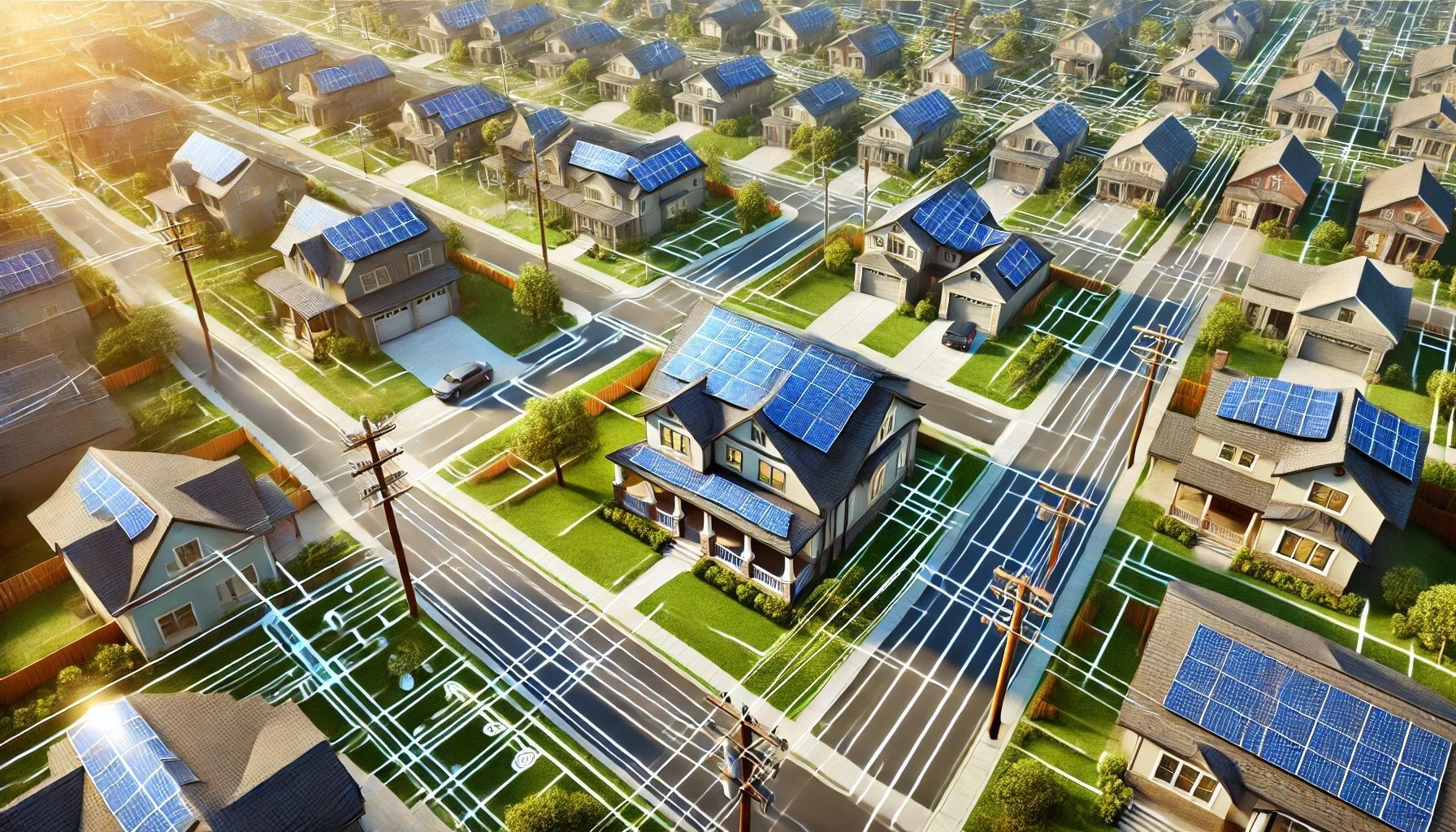The Ethos Green Power Cooperative Blog
Free Quotes
Referral Discounts Available
Lifetime Support

The Midwest Renewable Energy Association (MREA) is thrilled to announce the new Grow Solar La Crosse program for 2025. Building on years of experience with solar programs in the area, this year’s group buy is an opportunity for residents to purchase a home solar system at a below-market cost. Click the button below to sign up for a free site assessment, or to get email updates about the program. SIGN UP Partnering with local governments and community groups, the program is designed to help homeowners and small businesses cut down on energy costs by offering discounted solar panel installations. With energy bills on the rise, switching to solar can be a smart way to embrace clean energy while saving money in the long run. “In times of uncertainty and climbing prices, one thing remains the same: we all need electricity,” says Evonne Waugh, Grow Solar’s program manager. “Investing in solar means securing lower bills for many years ahead.” Through a solar group buy, community members join together to get better pricing on solar panel installations. Grow Solar will host free educational sessions, known as “Solar Power Hours,” to help everyone understand the ins and outs of solar energy. After these sessions, interested homeowners will be connected with a trusted solar installer for personalized site assessments and project proposals. Viroqua-based Ethos Green Power Cooperative has been independently selected to be the program’s installer in 2025. “We’re thrilled to be working with the Grow Solar program to expand solar access in our region,” says Tomas Herrera, a sales and marketing coordinator at Ethos. “Our core focus is empowering our communities through electrification, and we’re stoked to share the benefits of solar power with our neighbors in La Crosse County this year.” The financial benefits of switching to solar are clear and long-lasting."Once installed, solar panels generate immediate savings on your electric bill," says Lewis Kuhlman, Environmental Planner for the City of La Crosse. 'And since panels are backed by a 25-year guarantee and last for decades, they make owning a solar array a wise long-term investment.” Grow Solar programs have been offered in 24 markets across six Midwestern states over the past 12 years. Nearly 25 megawatts of new clean energy generation has been added through those programs, producing millions of kilowatt-hours of clean power every year. “Previous Grow Solar programs have collectively saved participants hundreds of thousands of dollars on their energy bills, and we want La Crosse County residents to access those savings!” says Jeff Schneider, communications coordinator for Grow Solar. “Incentives that make solar panels much more affordable are still in place, making 2025 a great time to make the switch to solar.” The program’s free Solar Power Hours will be hosted throughout the spring and summer, both in-person and virtually. In-Person Solar Power Hour: Thursday, June 26th at 5:30pm at the Holmen Library . Co-Hosted by La Crosse County Register In-Person Solar Power Hour: Tuesday, July 15th at 5:30pm at the Onalaska City Hall . Co-Hosted by the City of Onalaska Register Virtual Solar Power Hour: Thursday, July 24th at 2:00pm, online via Zoom. Register In-Person Solar Power Hour: Thursday, August 7th at 5:30pm at the Nature Place . Co-Hosted by the City of La Crosse and La Crosse County Register About Midwest Renewable Energy Association (MREA): The Midwest Renewable Energy Association promotes renewable energy, energy efficiency, and sustainable living through education and demonstration. Based in Custer, Wisconsin, MREA provides renewable energy career training and solar group buy programs across the Midwest. About Grow Solar La Crosse: Grow Solar La Crosse, led by MREA, the City of La Crosse, the City of Onalaska and La Crosse County, facilitates group buying of solar panels to make solar energy accessible and affordable for residents and businesses in La Crosse county. About Ethos Green Power Cooperative: Ethos Green Power Cooperative is a full service solar installer based in Viroqua and serving Southwestern Wisconsin. Their mission is to provide the highest quality renewable energy services to the rural areas surrounding Viroqua, as well as creating new sustainable jobs, stabilizing the cost of electricity and moving away from fossil fuel dependence.

When the Vernon Economic Development Association (VEDA) transformed a former factory into the Food Enterprise Center, it opened the door for dozens of small businesses to thrive in Viroqua. In 2023, the Center added a 100 kW solar array – 30% of which was funded through the Inflation Reduction Act’s direct pay provision. In this video, tenants of the Center share how on-site solar is lowering their energy costs, helping them to grow their businesses and reinvest in their community. With these federal incentives now at risk, local entrepreneurs speak out about what’s at stake – and why continued investment in rural communities and small businesses is “a really important piece in moving America forward together.”

On January 20, 2025 the Environmental Protection Agency, under new management, froze $7 billion in contracts awarded through the Solar for All program. Withdrawing funding for programs like Solar For All and the USDA REAP program are a direct blow to the powerful work being done in Wisconsin to maintain economic vitality, energy independence, and environmental stewardship. The EPA committed $62.4 million in Wisconsin, with $50 million specifically dedicated to lowering electric bills for nearly half of working families. Moreover, the USDA awarded $66.7 million in REAP grants according to a press release that has been removed from the USDA website . This funding has proved successful in supporting our farmers and communities while also helping to stem the rising cost of electricity as a whole . In short, solar energy empowers not only individual households but entire communities by ensuring neighborhoods have reliable access to power and helping to keep local energy costs down. The Viola Municipal solar project installed by Ethos Green Power is a testament to community impact. Designed to produce 12.84% of Viola’s current energy needs , the project pairs solar with 440 kWh of battery storage to ensure that affordable, locally generated power is always available—even during peak demand. With an ROI of just 3.5 years , it is projected to generate over $4 million in electric bill savings over 30 years, turning investment into immediate and long-term community benefits. Environmentally, the project cuts 504 metric tons of CO₂ annually , equivalent to powering 98 homes every year. Federal funding like the EPA’s Solar for All grant is critical for supporting Wisconsin’s solar industry— a key economic driver in a state without fossil fuel resources . In fact, solar power jobs make up over a third of all Electrical Power Generation jobs in the state —more than twice the next-highest segment of wind—while 73,398 of the state’s energy workers are employed in clean energy. These sustainable, good-paying jobs align perfectly with the “all of the above” energy strategy embraced by Federal policy makers. The demand for solar energy is unchallenged. Consumers are determined to own their power and embrace the freedom of choice that comes with access to solar energy. Solar can be deployed faster and more affordably than most traditional electricity generation methods—especially compared to nuclear—and with rapidly decreasing costs of energy storage solutions, the momentum for solar is unstoppable. The people of Wisconsin will continue doing the work we do to secure our energy future in America—whether the federal government recognizes us or not. We hope it doesn’t come to that, but we’re strong enough to take our energy destiny into our own hands.

The Data Center Boom and Our Grid "Artificial Intelligence" (AI) projects (that make possible the image shown above) require massive computing power. An AP News story highlights how Amazon and Microsoft alone are driving huge expansions in data center capacity, creating an “ unprecedented strain on local power grids .” According to a Utility Dive analysis, data center load growth could soon make up a noticeable chunk of our total electricity demand, pushing costs higher for everyday folks. The U.S. Department of Energy recently released a report noting that "data centers consumed about 4.4% of total U.S. electricity in 2023 and are expected to consume approximately 6.7 to 12% of total U.S. electricity by 2028." Add in the looming possibility of more extreme weather events that demand extra heating or cooling, and our state’s power needs will spike even further. There's no silver bullet when it comes to the complex task of solving the onslaught of demand for power. We can't dig (or drill) ourselves out of this problem. We need an "All of the Above" strategy of practical, ready-to-go technologies to meet this moment. Look Up A recent Reuters article underscores the complexity of transforming the nation’s power grid. But complexity shouldn’t paralyze us. Instead, let’s tackle it one piece at a time. In Wisconsin, we have a rock-solid workforce of trained tradespeople and strong communities ready to invest in locally generated power –all we have to do is look up. The sun does not discriminate. Its power is available to all who choose to capture it. What's even more, solar power can be deployed quickly and affordably with very little bureaucracy–right in our own backyards and on rooftops! This fact has not gone unnoticed by big tech. Plans for a $100 billion ( maybe $500 billion? ) Stargate AI venture championed by the President emphasizes that solar is going to be a key power source . The rationale is simple– power generated behind the meter eliminates costs and inefficiencies associated with centralized power generation, long-distance transmission, and utility fees. Plugging into their very own solar power plant, businesses and homeowners gain energy independence and resilience at a relatively stable and predictable cost. On-site generation coupled with battery storage can continue to power essential loads during grid outages and potentially eliminate charges associated with peak demand or "time of use" rates. Sure, wind, hydro, and maybe nuclear each have their own part to play, but let’s face it—building a new plant here in Wisconsin would be a massive undertaking requiring specialized engineers, federal approvals, and years of planning. If we look at the speed of deployment, cost of installation, and immediate availability of trained local workers , solar is front and center. Solar farms and rooftop installations can pop up in months and scale quickly as demand increases. A Local Lifeline: Why Solar Works in Wisconsin If there’s one thing Wisconsinites know, it’s how to rally around each other when things get tough (especially if there’s cheese or beer involved). Local, renewable power is a natural extension of that community spirit. The U.S. Energy Information Administration forecasts that U.S. power usage will jump to record highs in 2024 and 2025 . That might sound intimidating, but it also spells opportunity for Wisconsin’s economy. By investing in renewables such as solar: We keep more energy dollars cycling in our own communities (think local jobs, local spending, local pride). We’re not left waiting on pricey nuclear projects or heavily specialized construction crews—solar can be rolled out relatively quickly by teams right here in Wisconsin. We build energy security , so we’re not at the mercy of out-of-state fossil fuels or international fuel costs. “Renewables were the fastest and cheapest energy generation capacity to deploy in the U.S. last year,” according to Canary Media . That’s not some fairy-tale marketing slogan—that’s a real stat pointing to our immediate, practical options. And in an economy where “local” is a badge of honor (just look at our farm-to-table culture), solar aligns perfectly with our values of self-reliance and community well-being .

What’s Causing Electricity Rates to Rise? Transmission and Grid Maintenance: Electricity prices are rising primarily due to the growing expense of delivering power across the grid, known as distribution and transmission costs. Utilities must maintain and upgrade aging infrastructure, respond to extreme weather events, and incorporate new technologies—all of which drive up the price of moving electricity from power plants to homes and businesses. While fuel and generation costs also factor in, the share devoted to distribution and transmission has surged, leading to higher rates for consumers. Fuel Price Fluctuations: Traditional fuels, such as natural gas and coal, can experience sharp price swings due to factors like global market conditions, supply constraints, and geopolitical events. When the cost of these fuels goes up, utilities often pass those increases on to their customers through higher electricity rates. This volatility makes energy bills less predictable and underscores the appeal of more stable-cost resources like renewables. Reality Check: While some people claim that expanding oil and gas drilling could substantially lower electricity costs, evidence suggests otherwise. According to data from the U.S. Energy Information Administration (EIA), oil plays a relatively small role in power generation, and expanding drilling generally has a limited, long-term impact on natural gas prices. Global market forces, distribution and transmission upgrades, and the growing competitiveness of renewables usually overshadow any short-term benefits from new drilling. In fact, much of today’s electricity rate increases stem from infrastructure and grid modernization costs rather than fuel prices. This indicates that the argument for cutting electricity bills significantly through more drilling is largely overstated. In addition to the cost of natural gas as a commodity , there are still substantial costs involved in running and maintaining natural gas power plants. As utilities move toward lower-emission technologies, many of the costs associated with fossil fuels are expected to rise, not fall. Essentially, we’re already depending heavily on natural gas, so increasing its use further won’t eliminate the operational and infrastructure expenses that come with burning fossil fuels. Furthermore, increasing demand on natural gas will only cause the price of the commodity to go up. This helps explain why shifting to energy sources with lower ongoing input costs—like solar and wind—can be more economical in the long run. How Solar Panels Counter Rising Rates Once you install solar panels, you start generating your own electricity and reducing the amount you buy from the utility. The result: an immediate drop in your monthly bill. • Attractive Return on Investment:
Rooftop solar systems often pay for themselves within a handful of years through reduced energy costs, incentives, and net metering credits —where you’re compensated for the excess electricity you send back to the grid. • Community-Wide Benefits:
When more homes generate power locally, utility companies can lower their distribution costs—less electricity has to travel long distances over power lines. This can help stabilize or even reduce rates for everyone. Exact figures can vary by system size, incentives, and local electricity rates, but data from RENEW Wisconsin and Focus on Energy indicates that homeowners in Wisconsin typically see a solar payback period of about 7–10 years. This assumes taking advantage of the federal Investment Tax Credit (ITC), plus any applicable state or utility incentives. The average savings of an Ethos customer is around $24,000 over the life of the system. The Power of Heat Pumps Heat pumps are an ultra-efficient way to heat and cool your home by moving heat rather than creating it. • Reduced Energy Use: Because they’re so efficient, heat pumps can significantly cut your heating and cooling costs. • Lower Carbon Footprint: If you power your heat pump with solar panels, you’re using clean energy to comfortably heat or cool your home, minimizing your environmental impact. • Better for the Grid: By using less electricity overall, heat pumps place less stress on utility infrastructure, helping to contain costs across your neighborhood. This means significantly lower utility bills compared to traditional HVAC systems—according to the U.S. Department of Energy, heat pumps can cut heating energy use by about 50%. Their ability to both heat and cool a space makes them incredibly versatile and scaleable for a wide range of environments. For older homes, workshops and mother-in-law apartments, ductless (mini-split) heat pumps are popular because they’re easy to install without extensive ductwork , and they efficiently provide both heating and cooling. In multi-family or hospitality applications, larger centralized or variable-refrigerant-flow (VRF) heat pump systems can handle multiple units at once, optimizing energy use across the property. Even in specialized settings like boats , heat pumps can be used to regulate temperature efficiently in tight quarters. Wherever they’re used, heat pumps offer efficient comfort at a low operating cost. BTM Efficiencies: Saving You Money and Helping Your Neighbors “Behind-the-meter” resources—like solar panels, heat pumps, and other energy efficiency upgrades—aren’t just about your individual savings. They create a ripple effect: • Reduced Strain on the Grid: Generating some of your own power or using less energy means utilities don’t have to ramp up as many power plants, ultimately slowing rate increases. • Lower Distribution Costs: The less electricity that needs to flow from distant power plants to your area, the less utilities pay for things like transmission maintenance, lowering bills for everyone connected to that grid. • Community Resilience: Distributed energy resources can keep neighborhoods powered if grid disruptions occur, adding another layer of reliability. According to the Lawrence Berkeley National Laboratory, distributed solar alone has helped offset billions in infrastructure upgrades by reducing peak demand on the grid. Meanwhile, a study by the National Renewable Energy Laboratory (NREL) shows that a typical 6 kW residential solar system can eliminate roughly 6 to 7 metric tons of carbon dioxide emissions each year, underscoring how BTM technology not only cuts homeowner energy bills but also reduces strain on the overall energy ecosystem. Environmental and Social Benefits • Cutting Carbon Emissions: Solar and heat pumps rely on clean, renewable energy, leading to fewer greenhouse gases. • Leading by Example: When neighbors see the financial and environmental benefits of BTM solutions, they’re more likely to adopt them—multiplying the positive impact on the entire community. • Healthier Communities: Fewer emissions mean less pollution, which translates to cleaner air and a healthier environment for everyone. The Bottom Line Rising electricity prices don’t have to be inevitable. By investing in rooftop solar, installing efficient heat pumps, and taking advantage of other energy-saving upgrades, you can save money, earn a robust return on investment, and help lower costs for your entire neighborhood. Plus, you’ll be doing your part to protect the environment and create a more resilient energy future for everyone. If you’ve been on the fence about solar or switching to a heat pump, now is the time to take action—your wallet, your neighbors, and the planet will thank you.

Last year witnessed significant advancements in renewable energy, marked by the completion of large-scale solar projects, strategic investments in clean energy infrastructure, and the implementation of state-level initiatives aimed at promoting sustainability. Badger Hollow Solar Farm: Located in Iowa County, the Badger Hollow Solar Farm became fully operational in early 2024. As Wisconsin's largest solar park, it features approximately 830,000 panels capable of powering over 75,000 homes. The project represents a substantial step toward increasing the state's renewable energy capacity. WIKIPEDIA Grant County Solar Project: Alliant Energy completed a 200-megawatt solar project in Grant County, providing enough energy to power more than 50,000 homes. This project is part of Alliant's broader initiative to expand renewable energy sources across the state. WPR Investments and Infrastructure Developments Launch of HEAR Program: Wisconsin has officially launched the Home Electrification and Appliance Rebate (HEAR) Program, funded by $74.5 million from the federal Inflation Reduction Act (IRA). It provides instant rebates to low- and moderate-income households for energy-efficient appliances, reducing monthly energy costs. FOCUS ON ENERGY Dairyland Power Cooperative's Renewable Initiatives: Based in La Crosse, Dairyland Power Cooperative secured nearly $573 million through the USDA's Empowering Rural America (New ERA) program. This funding will support the procurement of 1,020 megawatts of renewable energy via four solar and four wind installations across rural areas in Wisconsin, Iowa, Minnesota, and Illinois. The initiative aims to create well-paying jobs, significantly reduce emissions, and lower energy costs for rural communities. REUTERS UW-MADISON ENGINEERING Local Solar and Battery Projects: In La Crosse County, Dairyland plans to invest $15.6 million to install 2 megawatts of solar photovoltaic generation at two sites, connected to a 4 megawatt-hour battery energy storage system. This setup is expected to produce enough electricity to power up to 1,000 homes, enhancing local renewable energy capacity and grid reliability. RURAL DEVELOPMENT Cardinal-Hickory Creek Transmission Line: The 102-mile, 345-kilovolt transmission line connecting Iowa and Wisconsin became operational in September 2024. This infrastructure project is designed to enhance electrical reliability and support the integration of renewable energy projects in the region. State-Level Initiatives Wisconsin's Clean Energy Plan Progress Report: The state's Office of Sustainability and Clean Energy released its 2024 progress report, outlining achievements toward transitioning Wisconsin to a clean energy economy. The plan emphasizes goals such as achieving 100% carbon-free electricity consumption by 2050 and creating over 40,000 jobs by 2030. WISCONSIN SUSTAINABILITY OFFICE We Energies' Renewable Energy Expansion: We Energies filed plans to build five new large-scale renewable energy projects, including 500 megawatts of solar power and 180 megawatts of wind power. These projects are expected to power approximately 250,000 homes, further advancing the state's renewable energy infrastructure. The plan includes 100 MW of new battery storage, which would be charged during the day to provide customers with "sunshine after sunset." FOX6 NOW MISO's $4 Billion Transmission Projects in Wisconsin: Driven by the need to accommodate increasing renewable energy generation, the Midcontinent Independent System Operator (MISO) has outlined plans for $4 billion in transmission projects in Wisconsin. MISO estimates that construction will generate between 4,000 and 12,257 jobs and between $817 million to $4.5 billion in economic output. These projects aim to enhance the state's electrical grid to support the growing influx of renewable energy sources. URBAN MILWAUKEE

Wisconsin is continuing to lead in transitioning toward a clean energy future through large-scale investments, infrastructure upgrades, and renewable energy development. Significant federal investments, such as the Inflation Reduction Act funding for programs like HEAR and HOMES and the $2.5 billion loan guarantee for We Energies projects, showcase how federal and state governments are aligning resources to accelerate renewable energy adoption. Wisconsin is leveraging various renewable energy sources, including solar, hydropower, and energy storage. Large-scale solar projects like Vista Sands and Charter Steel's installation complement smaller-scale initiatives, such as behind-the-meter solutions. These initiatives not only reduce carbon emissions and dependence on fossil fuels but also provide economic benefits by creating jobs, lowering energy costs for residents, and supporting local businesses. Projects like the Cardinal-Hickory Creek transmission line and American Transmission Co.’s grid upgrades reflect a broader strategy to modernize electricity infrastructure. This ensures the grid can handle increased renewable energy inputs while meeting growing demand from electrification efforts. Concerns about compatibility with existing natural environment continues to be a hot button issue, with proponents of conservation arguing for more localized energy production and distribution. American Transmission Co. Pursues Major Grid Projects: Pewaukee-based American Transmission Co. (ATC) is vying for a substantial portion of a $3.8 billion initiative to upgrade Wisconsin's power grid. This effort is part of a larger $21.8 billion plan by the Midcontinent Independent System Operator (MISO) to enhance electricity transmission across the Midwest. The upgrades aim to accommodate increasing electricity demands from data centers, electric vehicles, and other emerging technologies, ensuring grid reliability and supporting the integration of renewable energy sources. Projects are scheduled for completion between 2032 and 2034, pending approvals from the Public Service Commission of Wisconsin and MISO's contractor selection process. BIZ JOURNALS (paywall) We Energies Secures $2.5 Billion for Renewable Projects: We Energies has received a conditional commitment for a loan guarantee of up to $2.5 billion from the U.S. Department of Energy's Loan Programs Office. The funding will support the development of over 1,650 megawatts (MW) of utility-scale renewable power generation and energy storage projects across Wisconsin, including the rehabilitation of the Big Quinnesec Falls hydropower facility near Iron Mountain, Michigan. Significance: This marks the first loan guarantee under a program created by the Inflation Reduction Act, reflecting a significant federal investment in Wisconsin's renewable energy infrastructure. RENEWABLES NOW Completion of Controversial Cardinal-Hickory Creek Transmission Line: The 345-kilovolt Cardinal-Hickory Creek transmission line, spanning 102 miles between Iowa and Wisconsin, has been completed after 13 years of planning and construction. The line is designed to transport clean energy from renewable sources in Iowa to consumers in Wisconsin, enhancing grid reliability and supporting the integration of renewable energy projects in the region. The project faced significant environmental opposition and legal challenges but proceeded following a federal appellate court decision earlier this year. ASSOCIATED PRESS WPR Further Reading: American Transmission vies for piece of $3.8B in Wisconsin power-grid projects (paywall) WEC Energy gets USD-2.5bn loan guarantee for renewables in Wisconsin Utilities complete transmission line linking Iowa and Wisconsin Construction underway for controversial transmission line through wildlife refuge

Recent developments in Wisconsin's solar energy sector highlight a significant expansion, with large-scale projects receiving approval and moving toward construction. This growth underscores the state's commitment to renewable energy and its potential to power a substantial number of homes with clean electricity. Key Developments: Launch of HEAR Program: Wisconsin has officially launched the Home Electrification and Appliance Rebate (HEAR) Program, funded by $74.5 million from the federal Inflation Reduction Act (IRA). It provides instant rebates to low- and moderate-income households for energy-efficient appliances, reducing monthly energy costs. The HEAR Program joins the Home Efficiency Rebate (HOMES) Program, offering comprehensive energy-saving rebates. Wisconsin is among the first states to roll out both initiatives. STATE AFFAIRS HEAR Income-Based Rebate Recap: Households below 80% of Area Median Income (AMI): Eligible for rebates covering up to 100% of project costs, with a maximum of $14,000. Households between 80% and 150% of AMI: Eligible for rebates covering up to 50% of project costs, also capped at $14,000. Households above 150% of AMI: Not eligible for HEAR rebates. Eligible Upgrades and Maximum Rebates: ENERGY STAR Electric Heat Pump Water Heater: Up to $1,750. ENERGY STAR Electric Heat Pump for Space Heating: Up to $8,000. ENERGY STAR Electric Heat Pump Clothes Dryer: Up to $840. ENERGY STAR Electric Stove, Cooktop, or Range: Up to $840. Insulation, Air Sealing, and Ventilation: Up to $1,600. Electrical Load Service Center (Electrical Panel): Up to $4,000. Electrical Wiring: Up to $2,500. Approval of Vista Sands Solar Project: The Wisconsin Public Service Commission has approved the Vista Sands Solar Project, set to be the largest in the state's history. Located in Portage County, the project will generate over 1,300 megawatts (MW) of electricity, sufficient to power more than 200,000 homes. It will also include a 300 MW battery energy storage system, enhancing grid reliability. Construction is slated to begin in March 2025, with completion expected by December 2028. WISFARMER Completion of Paris Solar Park : Southeastern Wisconsin's first large renewable energy project, the Paris Solar Park, is now fully operational. Situated in Kenosha County, the 200 MW facility comprises nearly 500,000 solar panels, providing enough energy to power approximately 60,000 homes. The project was constructed primarily by Wisconsin union workers, contributing to local employment. WE ENERGIES NEWS SunVest Solar's Project at Charter Steel: SunVest Solar has completed a 19.5 MW solar installation at Charter Steel's manufacturing facility in Saukville, marking Wisconsin's largest behind-the-meter solar project. This installation directly powers the steel mill with clean, local electricity, demonstrating the industrial sector's shift toward renewable energy sources. SOLAR POWER WORLD These projects reflect Wisconsin's proactive approach to expanding its renewable energy infrastructure, contributing to environmental sustainability and economic growth through job creation and energy cost savings. Further Reading: Gov. Evers, PSC of Wisconsin: Announce launch of Home Electrification and Appliance Rebate Program Largest solar project in Wisconsin history approved by state regulators First large solar project in southeastern Wisconsin is now powering the grid Wisconsin’s largest behind-the-meter solar project directly powers steel mill



Share On: